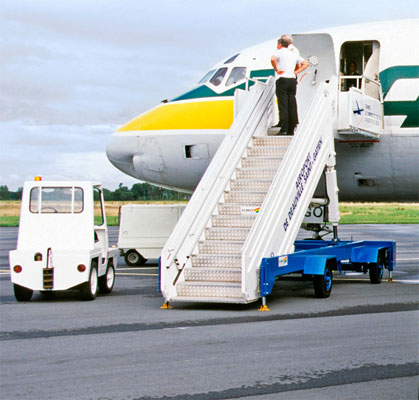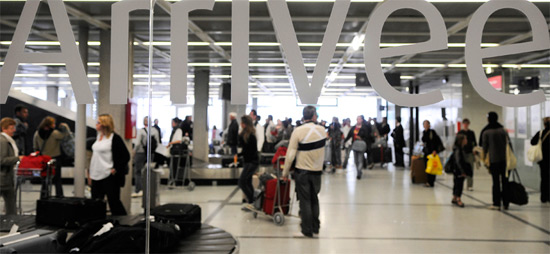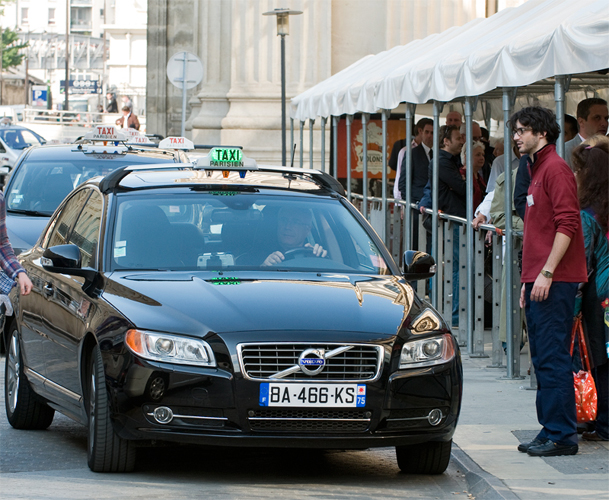By plane
While those coming to France from within Europe have many different transport choices, families travelling from the Americas, Australasia, Africa and Asia will have to fly. Fortunately, there are several options to choose from, including Air France, the national airline, with flights from many destinations across the world.
Other main carriers offering frequent flights from major European cities include British Airways, Iberia, Lufthansa, KLM and Alitalia. These airlines serve the two main airports of Paris – Roissy Charles-de-Gaulle and Orly – and sometimes larger regional airports such as Nice, Toulouse, Bordeaux, Lyon or Marseille. Several budget airlines, including easyJet, Flybe, Jet2, and Ryanair, also serve some smaller regional airports. These airports are mainly linked to the UK, Ireland, Germany, Belgium, the Netherlands and Scandinavia.
Families flying in from the United States can pick from the many direct flights offered by major airlines, such as American, United and Delta. These fly in to Paris (Charles-de-Gaulle), with frequent connections from nearly 20 cities, including New York, San Francisco, Washington DC, Los Angeles and Chicago.
Those travelling from Canada can get excellent connections from Montreal and Toronto on Air Canada, United and Air France.
There are no direct flights from Australia or New Zealand. However, Qantas has many connections with one or more stops, usually in Hong Kong, Dubai, Singapore, Frankfurt or London. Be aware that these usually take close to 24 hours.
Many domestic flights run to one of Paris’s two main airports – Orly and Roissy-Charles-de-Gaulle. Air France and its subsidiaries, such as Brit Air or Air Corsica, provide most connections, but many regional airlines – Twin Jet, Chalair Aviation and Airlinair – also fly some routes. To miss out the connection from Paris, Western France can be reached by way of other European hubs – London, Frankfurt, Munich and Amsterdam are the primary ones. This can help save time and money.
Deauville
Just 5 km (3 miles) east of Deauville, this airport offers chartered and direct flights to London with Cityjet. The airport is easy to get around. There is a restaurant.
Rennes-St Jacques
Located 8 km (5 miles) southwest of Rennes, just off the rocade (bypass), this airport is used by Air France, Flybe, Vueling, Hop! and Aer Lingus. Bus 57 (€1.20), which goes to the city centre, has a stop near the airport. Families with a lot to carry may want to take a taxi (€20). The airport services are easy to locate. There is a restaurant and a café.
Dinard-Pleurtuit-St Malo
The airport is situated 5 km (3 miles) southeast of Dinard on the D64 and 13 km (8 miles) from St-Malo. Ryanair and Aurigny fly here. There are no shuttle buses, but taxis (€13 for Dinard; €25–30 for St-Malo) and car hire are available at the airport. The airport is small and easy to get around. There is a restaurant. The nearest hotel is the Kyriad Saint-Malo Dinard (0299560926; www.kyriadsaintmalo.fr), with family rooms.
Brest-Bretagne
In Guipavas, 10 km (6 miles) northwest of Brest, just off the E50, Brest-Bretagne is served by Air France and Chalair (to Paris and Lyon), and Flybe, Cityjet, Volotea, Hop!, Jetairfly, easyJet, Vueling, Finist’ Air and Ryanair to other destinations.. Shuttle buses (€1.35) link the airport to the centre of Brest and the train station. It is a small airport and is easy to get around. There is a restaurant and sandwich/crêperie/bar. Hôtel Oceania Brest Aéroport (0298023283; www.oceaniahotels.com) is pleasant and closest to the airport.
Lorient-Bretagne Sud
This airport is located 10 km (6 miles) west of Lorient on the D163 and is served by Air France. It is linked to Lorient’s city centre by taxi or hire car only. It is a small airport and closes at night. There is no restaurant. The closest hotel is the Domaine de Kerbastic (Route de Locmaria, 56520 Guidel; 0297659801). There are several other accommodation options in Lorient.
Nantes Atlantique
Nantes Atlantique is 10 km (6 miles) southwest of Nantes, just off the péripherique (ring road) that encircles the city. It is served by Air France, Ryanair, Iberia, easyJet, Royal Air Maroc, Tunisair, Vueling, Jetairfly, Turkish Airlines, Air Méditeranée and Flybe. An airport shuttle (€7.50) runs every 30 minutes (every hour on Sunday) from the train station and Nantes centre, where the city’s three tram lines meet. Although this is one of the biggest airports in the west, it is easy to get around. There is a brasserie and several cafés/snack bars. The Hôtel Escale Oceania Nantes Airport (0240321414; www.oceaniahotels.com), close to the airport, has family rooms.
Angers Loire
British Airways flights fly from London to the small Angers Loire in Marcé, 27 km (17 miles) east of Angers, just off the A11. There is no public transport, just taxis. It is easy to get around and has a snack bar.
Tours Val de Loire
The airport is 6 km (4 miles) north of Tours, just off the A10. It is used by Ryanair flights. Alphacar shuttles (€5) go from the airport to Tours train station and depart from there two hours before each flight. The airport is small and easy to get around. There is a restaurant.
International Airlines
Air Canada
www.aircanada.ca
Air France
www.airfrance.com
Air Transat
www.airtransat.com
Alitalia
www.alitalia.com
American Airlines
www.aa.com
British Airways
www.britishairways.com
Delta
www.delta.com
easyJet
www.easyjet.com
Flybe
www.flybe.com
Iberia
www.iberia.com
Jet2
www.jet2.com
KLM
www.klm.com
Lufthansa
www.lufthansa.com
Qantas
www.qantas.com.au
Ryanair
www.ryanair.com
United
www.united.com
Regional Airports
Angers Loire
0241335020; www.angersloireaeroport.fr
Brest-Bretagne
0298328600; www.brest.aeroport.fr
Deauville
0231656565; www.deauville.aeroport.fr
Dinard-Pleurtuit-St-Malo
0299461846; www.deauville.aeroport.fr
Lorient-Bretagne Sud
0297872150; www.lorient.aeroport.fr
Nantes Atlantique
0892568800; www.lorient.aeroport.fr
Rennes-St Jacques
0299296000; www.rennes.aeroport.fr
Tours Val de Loire
0247493700; www.tours.aeroport.fr
Domestic Airlines
Air Corsica
www.aircorsica.com
Chalair Aviation
www.chalair.eu
Hop!
www.hop.fr
Twin Jet
www.twinjet.fr
By boat
France is served by several car ferry and catamaran companies sailing from the UK and Ireland, and for families, they can be the most economical, practical and also a comfortable way of travelling. Ferry terminals and ferries have cafés, snack bars, restaurants and shops; many have video games or play rooms for kids as well. While most ferries sail during the day, others sail overnight, allowing passengers to rest in their cabins before arriving at their destination. The most popular cross-Cannel ferry route is between Dover and Calais, which takes around 1 hour 15 minutes. P&O Ferries, My Ferry Link and DFDS Seaways frequently sail this route every day. P&O also has an overnight service from Hull to Zeebrugge in Belgium, a short drive from France. DFDS Seaways’ ferries sail between Dover and Dunkerque, which is a longer crossing than Calais (2 hours) but often cheaper. Brittany Ferries offer many options: from Portsmouth to Caen (6 hours or overnight), to Cherbourg on a fast-craft service (3 hours) and to St-Malo (overnight). Ferries also depart from Plymouth to Roscoff (6 hours or overnight); those travelling late in the year can try the mid-November to mid-March ferry services from Plymouth to St-Malo (overnight). Ferries also sail from Poole to Cherbourg (2½ or 4½ hours) and from Cork in Ireland to Roscoff (once a week, 14 hours).
Irish Ferries run overnight from Rosslare in Ireland to Cherbourg and Roscoff, with several sailings each week (more frequently in summer).
The ferries of LD Lines sail from Newhaven to Dieppe and from Portsmouth to Le Havre in just a few hours. A service also runs from Gijón in Spain to St-Nazaire.
Condor Ferries sail from Poole to St-Malo (6 hours). They also offer year-round links from Weymouth to St-Malo, via the islands of Guernsey and Jersey. Corsica Ferries link Corsica to Italy, travelling from Savona to Bastia (6 hours), Île Rousse (6 hours) and Calvi (6 hours), as well as from Livorno to Bastia (4 hours).
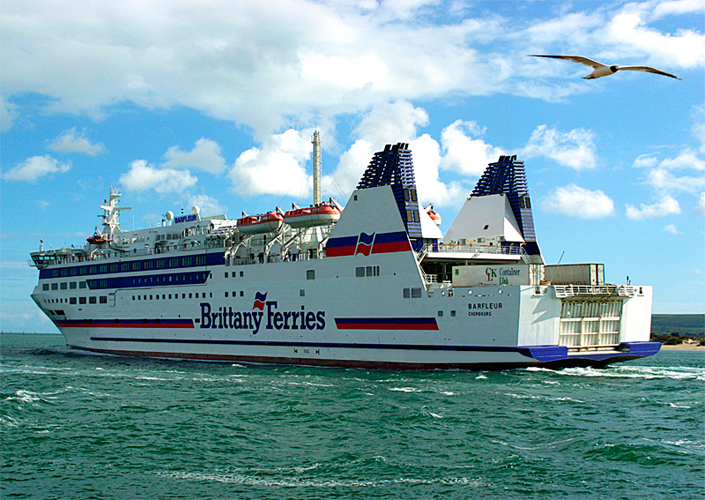
A Brittany Ferries ferry crossing the Channel between England and France
Taking private vehicles
All ferries have vehicle-carrying facilities. If you want to really explore the French countryside at your leisure, taking your own car is the best option, and need not be expensive. Fares are now generally per vehicle.
For a fast alternative, check out EuroTunnel’s rail service, Le Shuttle. Traversing the 52-km (31-mile) long Channel Tunnel, the shuttle allows motorists to drive aboard specially constructed trains and travel from Folkestone in the UK to Calais in France. The high-vehicle carriages can accommodate camper vans, cars, roof racks with bikes and mini-buses. The terminals on either end have cash dispensers (bureaux de change), food outlets, shops, baby-changing facilities and toilets. The Folkestone terminal has an outdoor playground and picnic tables. One ticket covers the car and up to nine passengers. The trip takes only 35 minutes; there are four departures an hour in peak season. Book in advance and, if possible, journey in off-peak times to get the most competitive rates.
Brittany Ferries
www.brittany-ferries.co.uk
Condor Ferries
www.condorferries.co.uk
DFDS Seaways
www.dfdsseaways.co.uk
LD Lines
www.ldlines.co.uk
P&O Ferries
www.poferries.eu
My Ferry Link
www.myferrylink.com
By train
One of the best ways for families to travel to France from Europe is via train. You get to see more of France before arriving at your destination and kids have a good time. The high-speed train service, Eurostar, links England to France. The journey starts off from London St-Pancras and reaches Paris in just 2 hours and 15 minutes. Some Eurostar trains to Paris stop in Calais and Lille and many run directly to Disneyland® Paris, as well as from London to Brussels via Lille. With Eurostar, it is easy to get to any part of France, by changing on to the TGV French high-speed rail network. Trains run frequently and year round, except on Christmas Day. In winter, direct Eurostar “ski trains” run from London to the French Alps.
High-speed links from Europe
There are several other international rail services with high-speed links to France and its national rail network, Société Nationale des Chemins de Fer (SNCF). This excellent network operates high-speed TGVs (Trains à Grand Vitesse), which connect Paris and other main French cities to Luxembourg, Brussels, Strasbourg, Berlin, Munich, Geneva, Zürich and Basel, among others. Many TGVs run in conjunction with other European services, such as DB Bahn, ICE and TGV Lyria. Trains run from Paris to Brussels, Amsterdam, Cologne and several other German cities on the Thalys network. Elipsos trains link Barcelona and Madrid to Paris; while Artesia trains link Rome, Milan and Florence to Paris and Lyon. To find out more about these services and their routes, check the TGV Europe, Railteam and Rail Europe websites.
The TGV Rhine-Rhône links the northeast with the southeast. There are many non-TGVs or regular trains that not just run the same routes, but also service smaller towns and villages. The fares are cheaper, and unlike the TGVs, reservations are not required, except for overnight trips. Travelling through the night on sleeper trains, with their bunks (couchettes), is an easy way to save on hotel bills. First class has four berths per compartment and second class has six berths per compartment. There is a good network of trains in Western France: at local level they are operated by the TER division of the SNCF (www.ter-sncf.com) with trains linking many towns in Normandy, Brittany, the Loire and Centre-Val de Loire. The region is also served by the high-speed TGV network, with lines from Paris, with links to Rouen and Le Havre, Le Mans, Rennes, Quimper and Brest, as well as Angers, Saumur, Tours, Nantes and the coast. Slower-speed trains run from Paris to Caen and northwest Normandy. The SNCF and TGV services also act as tour operators, offering great discounts on hotels, ski packages, flights and rental cars and bikes.
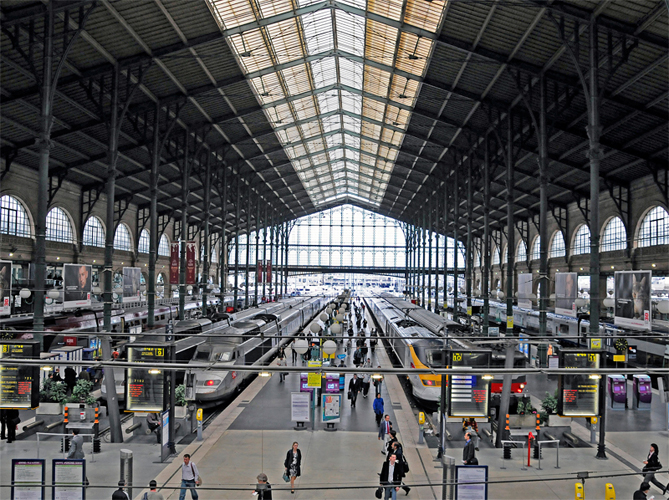
The Gare du Nord, one of Paris’s several international train stations
Fares and rail passes
Families travelling with children can take advantage of the many special discounts and deals offered by rail services. Eurostar fares are cheapest if bought up to 120 days in advance. They are easy to book on Eurostar’s website; but be aware that the very cheapest fares are non-refundable and not-changeable in case of any change in plans. SNCF fares are based on periods: blue (Monday 10am to Friday 3pm); white (Monday 5–10am, and Friday and Sunday 3–8pm); and red (Friday night, Saturday, Sunday morning and night and holidays); most discounts are offered only in the blue period. SNCF has a very useful online service for booking tickets. Before boarding, ensure all the tickets are validated in a composteur, a yellow machine at the station; or be subject to a fine. SNCF’s AutoTrain service allows motorists to transport their cars from Paris to many points, including Lyon, Toulouse, Bordeaux, Biarritz, Brive, Avignon and Nice. Motorail also offer similar services from cities in the Netherlands and Germany. Check the SNCF website for details of all these services.
TGV tickets come with a compulsory reservation charge; those travelling in peak hours pay an added rate. TGV Europe is a good website to check for discounts. Couples get a 25% discount on return tickets on TGVs and other trains as long as their journey starts in a blue period (Découverte à Deux); the same 25% reduction applies to a group of up to four people travelling with a child under 12 (Découverte Enfant Plus), to under 26s (Découverte 12–25) and over 60s (Découverte Senior).
Also look into InterRail passes, valid for 3–8 days of unlimited travel within a month; children (ages 4–11) get a 50% discount. These passes are only for European residents. Non-Europeans are eligible for a similar Eurail pass. There are many options on offer, as well as several discount deals on travel and hotels. For more details on these services, check the Rail Europe website.

A high-speed Eurostar train swishing through the French countryside en route to Paris
DB Bahn & ICE
www.bahn.com
Elipsos
www.elipsos.com
Eurail
www.eurail.com
European Rail
www.europeanrail.com
Eurostar
www.eurostar.com
EuroTunnel
www.eurotunnel.com
Rail Europe
www.raileurope.com
Railteam
www.railteam.co.uk
SNCF
www.sncf.com/en_EN
TGV Europe
www.tgv-europe.com
TGV Lyria
www.tgv-lyria.com
Thalys
www.thalys.com
By car
European visitors coming to France with kids and all the equipment they require may well find it cheaper and easier to drive their own motorhome or car. Motorways (autoroutes) in France are perfectly integrated into the European system. Vehicles can be transported across on ferries and trains as well (see '
By boat').
What to take
Car insurance is a legal requirement in France; drivers must carry their vehicle’s insurance policy, along with the original registration document, a European Accident Statement and a full driving license (drivers not from Canada, the USA, the EU or EEA should bring an international driving license). If you are not the registered owner, carry a letter from the owner giving you permission to drive the car. It is compulsory to carry passports or national ID cards too.
By law, the vehicle must carry within it a red warning triangle and a reflective waistcoat for any person who may step out of the car at the scene of an accident (this has to be kept in the car, not the boot). Snow chains are essential during winter and are even a legal obligation on some roads.
Car hire
Major international car hire firms are present in the larger cities, and Avis has branches in most towns. It is generally cheaper to book and pay for the car before arrival and absolutely vital in the summer, when cars are in short supply. When buying air tickets to France, look for fly/drive deals. The SNCF also offers train/drive packages, with pick-up points in all major train stations. See the Rail Europe website for details.
To hire a car, drivers have to be at least 21, and have held a full license for over a year. Be prepared to pay supplementary charges for a child seat, Sat-Nav (GPS), snow chains or automatic transmission. Motorhome Hire France and Avis Caraway hire out motorhomes and RVs.
Maps and planning
Even if the car has Sat-Nav, it is a good idea to carry a road atlas or maps for the area being visited. These are available at petrol stations or at any newsstand: ViaMichelin is an excellent route planner.
Sunday can be the best day to drive, since large trucks are banned from 10pm on Saturdays and days prior to public holidays, as well as Sundays and public holidays from midnight–10pm year round. Try to avoid the massive traffic congestion around major French holidays. City centres, with their traffic and one-way systems, can be frustrating; follow the handy Toutes Directions signs to get out of any town. Car parks in most towns (many underground) cost €3–5 an hour. Drivers wishing to avoid Paris should stick to the outer motorways, rather than trying the confusing routes closer to the city. Check the Bison Futé website for traffic forecasts and live information in English.
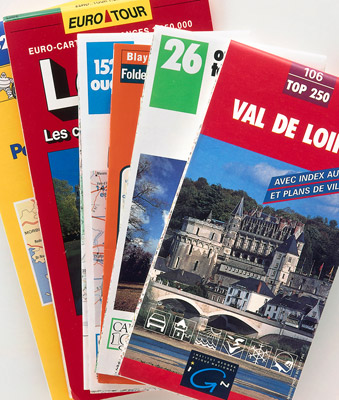
Regional maps useful for driving to and around France
Toll fares and petrol
Roads in France are well maintained and usually well signposted. Autoroutes (motorways) link all the major cities; most of these are péage (toll roads), charging an average €0.07 per kilometre for cars and more for caravans, motorhomes and RVs. Motorways can be expensive over long distances, but the N (Nationale) and D (Départmentale) roads offer a low-traffic alternative. The headlights of right-hand drive cars must be adjusted for left-hand driving, or be fitted with deflectors (available at all ports and ferries). Kids aged 10 and below are not allowed to sit in the front seat. A special rear-facing baby seat is allowed as long as the airbag is disabled. The speed limit on motorways is 130 km/h (80 mph), but is reduced to 110 km/h (70 mph) on rainy days, or 50 kmph (30 mph) in case of fog or snow. On N and D roads, the limit is 90 km/h (55 mph), regardless of the road’s width. After passing a white sign with a town’s name, the limit is 50 km/h (30 mph). Speeding fines start at €68, going up to €4,500 for a failed breathalyzer test. Non-French drivers may have to pay any fine in cash on the spot.
It is always cheaper to buy petrol at supermarkets. Many have 24-hour machines that accept credit cards. Full-service areas, with cafés, petrol stations and toilets are set up every 40 km (25 miles) on the motorways; unmanned rest areas are located every 10–20 km (6–10 miles). In case of a breakdown or accident, walk to the orange SOS phone boxes every 2 km (1 mile). For serious accidents, dial 15 or 18 for an ambulance.

Signs indicating lanes for cars, coaches, motorbikes and other traffic at the entrance to the Channel Tunnel
Auto Europe
www.autoeurope.com
Autoroutes
www.autoroutes.fr
Avis
www.avis.com
Avis Caraway
www.aviscaraway.com
Bison Futé
www.bison-fute.equipement.gouv.fr
Budget
www.budget.com
Carrentals
www.carrentals.co.uk
easyCar
www.easycar.com
France Car Hire
www.france-car-hire-rental.com
Hertz
www.hertz.com
Motorhome Hire France
www.motorhome-hire-france.com
National/Citer
www.citer.fr
Travel Supermarket
www.travelsupermarket.com
TT Car Hire
www.ttcar.com/uk
ViaMichelin
www.viamichelin.com


